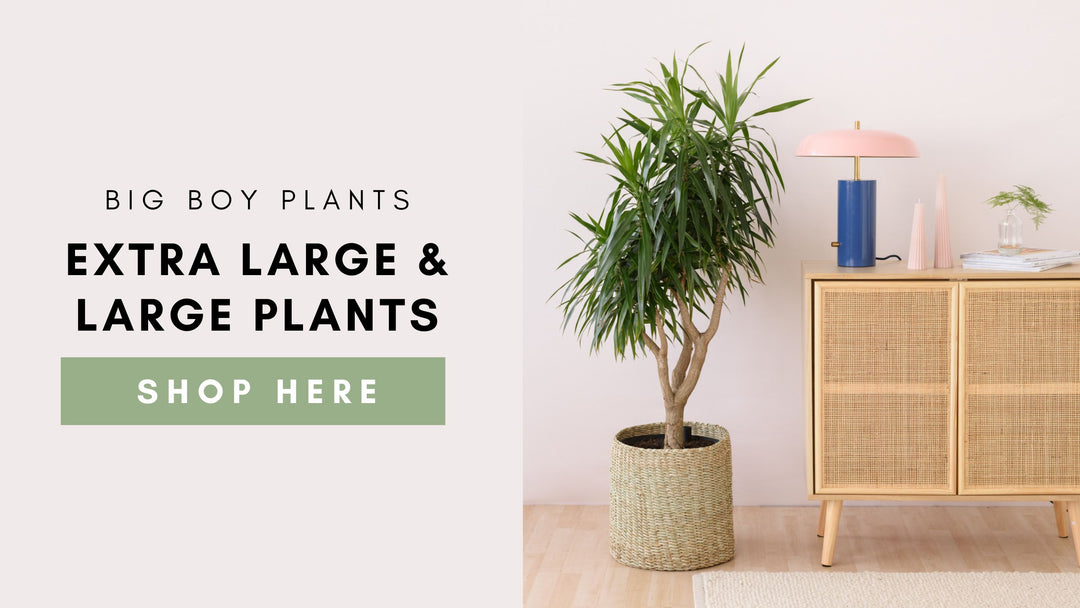Fiddle leaf fig Care Instructions
Scientific name: Ficus Lyrata
Synonyms: Fiddle Leaf Fig, Banjo Fig
Enormous leaves shaped like violins make Fiddle Leaf Fig a dramatic accent.
In its native habitat, this fig tree from the Moraceae family will reach 12 m tall. Fortunately, it grows very slowly and stays much shorter when grown indoors. Its bold, prominently veined leaves grow to 30 cm long and 15cm wide with wavy edges. Keep the naturally glossy leaves clean by wiping them often with a damp cloth. Read up more on 5 Fiddle Leaf Facts here.
Controlling its height is easy to do. Prune off the top of young plants to promote branching and to control its growth. You can also control its size by keeping it in a small container. You don't have to cut it back, though. The broad leaves of this fig tree make it a beautiful, live structural accent in a room with high ceilings. Read up more on 7 Steps for making your Fiddle Leaf Fig grow bigger, faster.
Although a bit fussy, fig plants make long-lived and beautiful indoor trees. Give your plant what it wants and you'll enjoy your Fiddle Leaf Fig for many years.
Please note: Toxic to pets and Humans
Fiddle Leaf Fig Common Symptoms
- Leaves dropping is fairly common with the Fiddle Leaf, especially when they have been moved to a new environment. In addition, changes in light levels and temperature can cause the leaves to drop. It may take a few weeks for your Fiddle Leaf to adjust to its new space, so don’t give up. While it may be tempting to repot, overwater or fertilize a shedding fig tree, don't do it. It'll only cause more stress to the tree and make the problem worse.
- Brown leaf tips: this is sometimes caused by soil that is too dry. Increase your watering. You can also run several cups or jugs of water through the potted plant (until water is running out of the drainage holes) to ensure that the roots are properly watered.
- Soft leaves with brownish patches: the likely problem here is overwatering, cold temperatures or a combination of both. If the plant continues in this regard, it will eventually die. Check if the soil is too wet from the top and through the drainage holes at the bottom (if possible). If, several days after watering, the soil is very soggy, you need to change your watering cycle, move the plant somewhere warmer or consider replacing the soil with a better draining type.
- Pests: Scale and Spider mite are the most common pests to invade a Fiddle Leaf. Look out for small brown insects that cling to stems and leaves, secreting a sticky residue on the plant which will indicate scale. If webbing appears between branches and leaves, it’s a tell-tale sign of a spider mite invasion. Educate on Houseplant Pest Identification, Prevention and Treatment here.
How to Deal with Leaf Loss in Fiddle Leaf Figs
If you’re struggling with leaf loss in your Fiddle Leaf Fig, it’s important to know that this is often a natural response to changes in environment. This can happen when the plant is moved from the store to your home, as these are completely different climates and lighting conditions. Fiddle Leaf Figs are particularly sensitive to such changes, which can lead to a common issue: bottom leaf drop that results in bare stems. The adjustment period can last up to three months, so patience and proper care are essential.
- Ensure Consistent Watering: Fiddle Leaf Figs are very sensitive to both overwatering and underwatering. During the acclimation period, keep the soil evenly moist, but avoid letting it become soggy. Water when the top 6-10 cm of soil feels dry; this is usually around every 7-10 days. If your plant is large, the soil may take longer to dry out. Consistent moisture is critical to prevent stress and leaf drop. Also, check for water left in the tray after 15 minutes of watering and drain it out to avoid root rot.
- Maintain Stable Temperatures: Ficus in general dislike sudden temperature changes, so keep them away from cold drafts, heating vents, or air conditioning units. Aim for a steady temperature between 15 and 24 °C. Drastic temperature shifts can cause stress that leads to leaf drop and eventually bare stems. Be mindful of this if your home has tile floors, which can affect temperature stability.
- Gradually Adjust Light Exposure: Fiddle Leaf Figs thrive in bright, indirect light. Moving a plant from low light directly into bright sunlight can shock it, leading to leaf drop. Introduce your Fiddle Leaf Fig to brighter light gradually over several days. Position it in a spot with some soft, morning sunlight for a maximum of 3 hours, as this can help it recover and boost growth. Keep the plant at least 30 cm away from windows where direct sunlight shines, as the glass can amplify the light and scorch the leaves.
- Increase Humidity: Ficus love moderate to high humidity, and dry indoor air can be stressful for them, contributing to leaf drop. You can boost humidity by misting the leaves regularly, placing a pebble tray under the plant (filled with pebbles and a little water), or using a humidifier to maintain a more comfortable environment. Increased humidity is key to keeping Fiddle Leaf Figs healthy.
- Avoid Frequent Relocation: Fiddle Leaf Figs are sensitive to being moved, which can lead to shock and leaf drop. Once you’ve found a suitable spot with stable light, temperature, and humidity, try to avoid moving it unless absolutely necessary. If relocation is required, move it gradually to help it adjust to the new environment.
- Feed Lightly with a Seaweed Fertiliser: During the growing season (spring and summer), fertilise your Fiddle Leaf Fig sparingly with a seaweed-based fertiliser, such as Kelpak. This type of fertiliser is high in growth hormones and can help the plant recover from stress. If your plant has lost a significant number of leaves, prune it lightly to encourage new growth and help it redirect energy toward recovery.
Fiddle Leaf Fig Care Instructions
- Origin Western Africa (Cameroon to Sierra Leone)
- Height: 90cm - 3m indoors and 12m outdoors
- Light: Bright indirect light year-round. Give your plant a quarter turn every week or so to expose all sides to light.
- Water: Keep soil evenly moist. Reduce watering in winter. Watering Tip: Give you Fiddle Leaf a good soak once a month for 10 – 20 minutes. Do this only if your plant is still small enough to move. To be water efficient, place the plant pot in a round pan within the bathtub or kitchen sink and, using a smaller jug, continue to water the plant with the water that has already drained out. Very important: Fiddle Leaf Figs like consistency. If you keep it on the moister side - then continue as such. And visa versa for a drier approach.
- Humidity: Average to medium-high humidity.
- Temperature: Average room temperatures 16-24°C. Keep it away from heat/AC vents or drafts from entryways.
- Soil: Any good draining potting mix.
- Fertilizer: Feed every 2 weeks during the growing season (spring-summer-autumn) with a balanced liquid fertilizer, and reduce this to monthly during winter.
- Repotting: When the plant is young you can re-pot it every spring into a slight bigger pot, but once it reaches your desired height, you can just replace the top soil each year. If the plant is top-heavy use a heavy plant to prevent the tree from falling over. Read up more on how to Repot your plant here.
- Pruning: Remove leaves that have seen better days as soon as they start deteriorating (check that the leaf deterioration is not due to plant problems). To keep the Fiddle Leaf at a desired height you should prune the top with a pair of Pruning Shears.
- Propagation: Stem tip cuttings and air layering. Propagating large-leaf fig trees is not easy for the amateur to do at home. These trees are slow to root from either method.
We stock a large selection of Fiddle Leaf Figs, all year round. Find one that suits you:
- Smaller Table Top Plants - to give you the enjoyment of watching the entire growth journey
- Medium sized Plants - for an already established plant
- Larger single stemmed Plants - great to hold some space
- Large 3 stemmed stunning stopping Plants - for extra impact
- Occasionally, we'll stock the dwarf Fiddle Leaf Bambino variety as well



